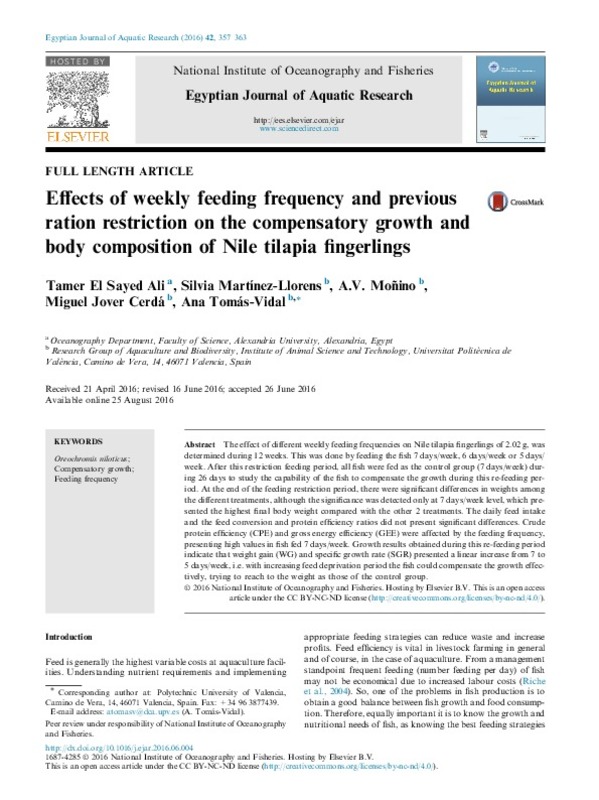JavaScript is disabled for your browser. Some features of this site may not work without it.
Buscar en RiuNet
Listar
Mi cuenta
Estadísticas
Ayuda RiuNet
Admin. UPV
Effects of weekly feeding frequency and previous ration restriction on the compensatory growth and body composition of Nile tilapia fingerlings
Mostrar el registro sencillo del ítem
Ficheros en el ítem
| dc.contributor.author | El Sayed Aly Hassan, Tamer
|
es_ES |
| dc.contributor.author | Martínez Llorens, Silvia
|
es_ES |
| dc.contributor.author | Moñino López, Andrés Vicente
|
es_ES |
| dc.contributor.author | Jover Cerdá, Miguel
|
es_ES |
| dc.contributor.author | Tomás Vidal, Ana
|
es_ES |
| dc.date.accessioned | 2017-12-21T10:46:55Z | |
| dc.date.available | 2017-12-21T10:46:55Z | |
| dc.date.issued | 2016 | es_ES |
| dc.identifier.issn | 1687-4285 | es_ES |
| dc.identifier.uri | http://hdl.handle.net/10251/93248 | |
| dc.description.abstract | [EN] The effect of different weekly feeding frequencies on Nile tilapia fingerlings of 2.02 g, was determined during 12 weeks. This was done by feeding the fish 7 days/week, 6 days/week or 5 days/week. After this restriction feeding period, all fish were fed as the control group (7 days/week) during 26 days to study the capability of the fish to compensate the growth during this re-feeding period. At the end of the feeding restriction period, there were significant differences in weights among the different treatments, although the significance was detected only at 7 days/week level, which presented the highest final body weight compared with the other 2 treatments. The daily feed intake and the feed conversion and protein efficiency ratios did not present significant differences. Crude protein efficiency (CPE) and gross energy efficiency (GEE) were affected by the feeding frequency, presenting high values in fish fed 7 days/week. Growth results obtained during this re-feeding period indicate that weight gain (WG) and specific growth rate (SGR) presented a linear increase from 7 to 5 days/week, i.e. with increasing feed deprivation period the fish could compensate the growth effectively, trying to reach to the weight as those of the control group. | es_ES |
| dc.language | Inglés | es_ES |
| dc.publisher | Elsevier | es_ES |
| dc.relation.ispartof | Egyptian Journal of Aquatic Research | es_ES |
| dc.rights | Reconocimiento - No comercial - Sin obra derivada (by-nc-nd) | es_ES |
| dc.subject | Oreochromis niloticus | es_ES |
| dc.subject | Compensatory growth | es_ES |
| dc.subject | Feeding frequency | es_ES |
| dc.subject.classification | PRODUCCION ANIMAL | es_ES |
| dc.title | Effects of weekly feeding frequency and previous ration restriction on the compensatory growth and body composition of Nile tilapia fingerlings | es_ES |
| dc.type | Artículo | es_ES |
| dc.identifier.doi | 10.1016/j.ejar.2016.06.004 | es_ES |
| dc.rights.accessRights | Abierto | es_ES |
| dc.contributor.affiliation | Universitat Politècnica de València. Departamento de Ciencia Animal - Departament de Ciència Animal | es_ES |
| dc.description.bibliographicCitation | El Sayed Aly Hassan, T.; Martínez Llorens, S.; Moñino López, AV.; Jover Cerdá, M.; Tomás Vidal, A. (2016). Effects of weekly feeding frequency and previous ration restriction on the compensatory growth and body composition of Nile tilapia fingerlings. Egyptian Journal of Aquatic Research. 42:357-363. doi:10.1016/j.ejar.2016.06.004 | es_ES |
| dc.description.accrualMethod | S | es_ES |
| dc.relation.publisherversion | https://doi.org/10.1016/j.ejar.2016.06.004 | es_ES |
| dc.description.upvformatpinicio | 357 | es_ES |
| dc.description.upvformatpfin | 363 | es_ES |
| dc.type.version | info:eu-repo/semantics/publishedVersion | es_ES |
| dc.description.volume | 42 | es_ES |
| dc.relation.pasarela | S\316453 | es_ES |








